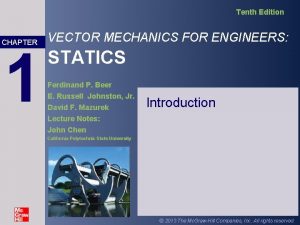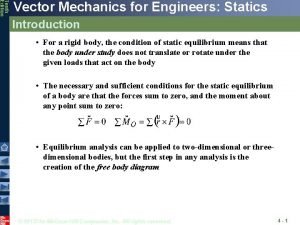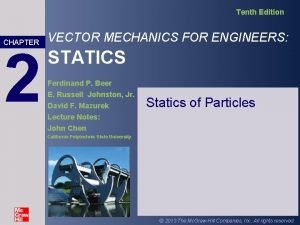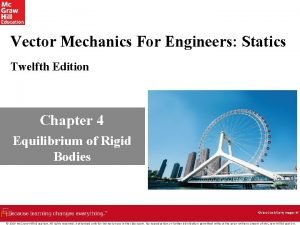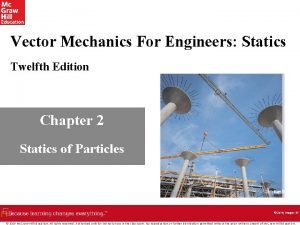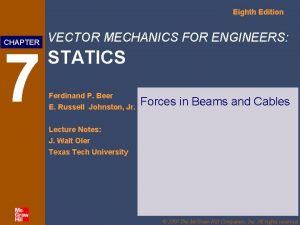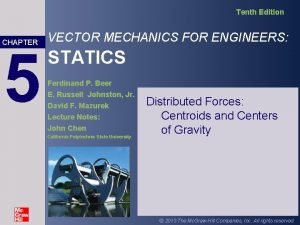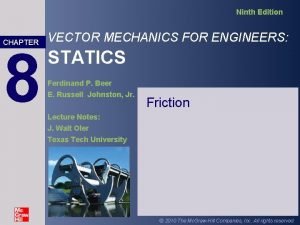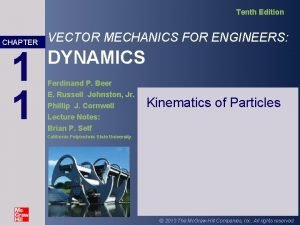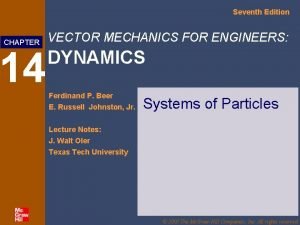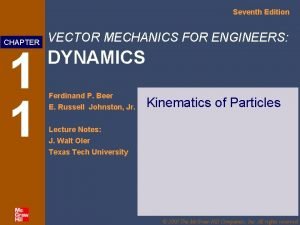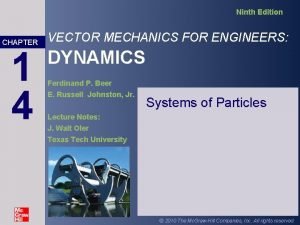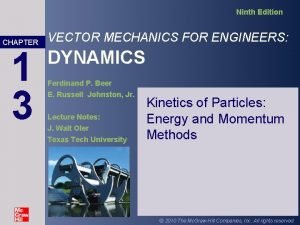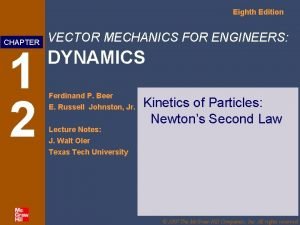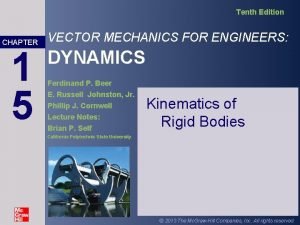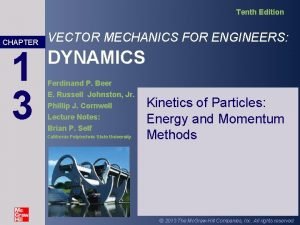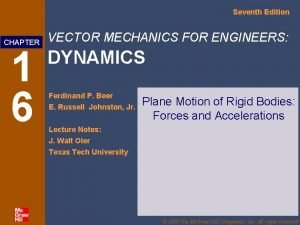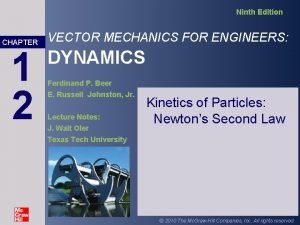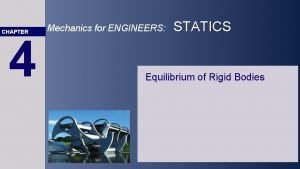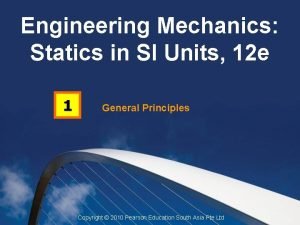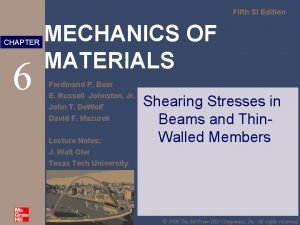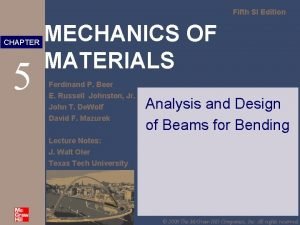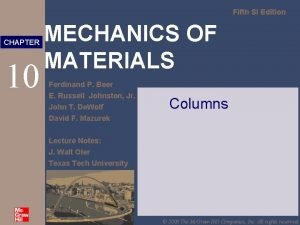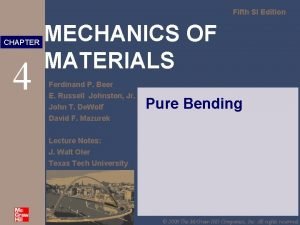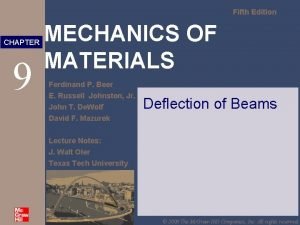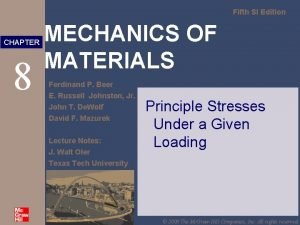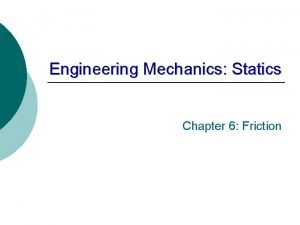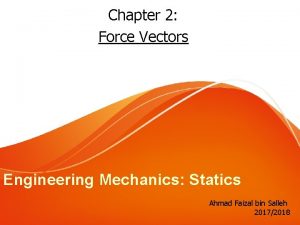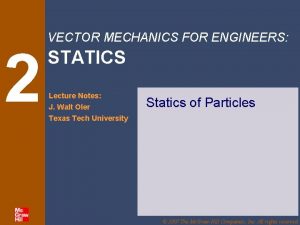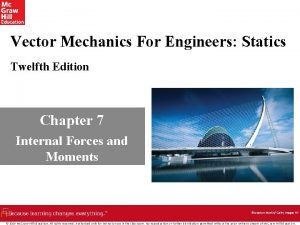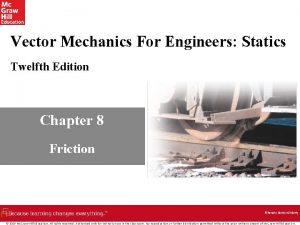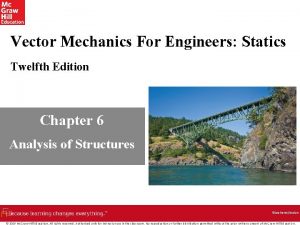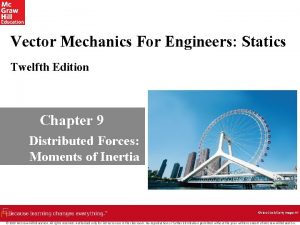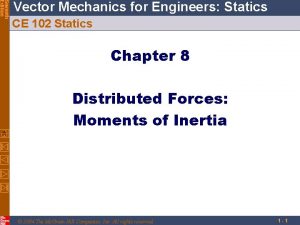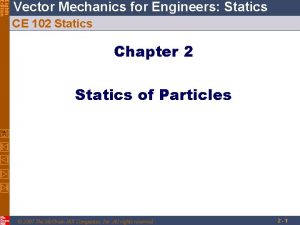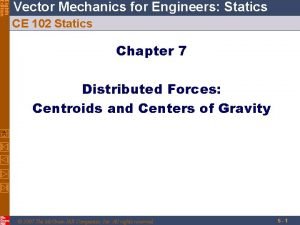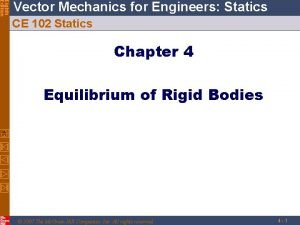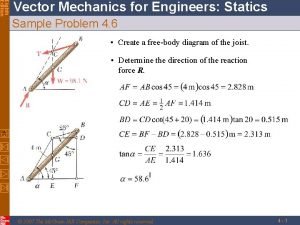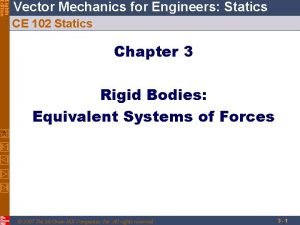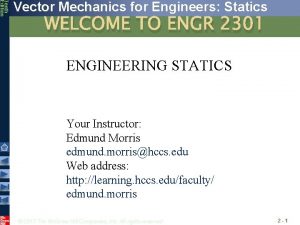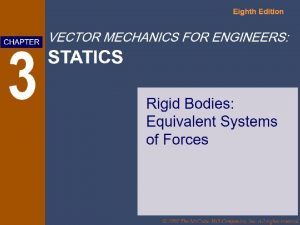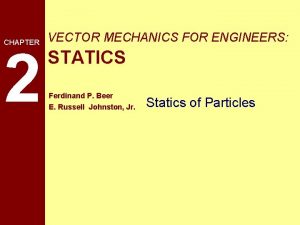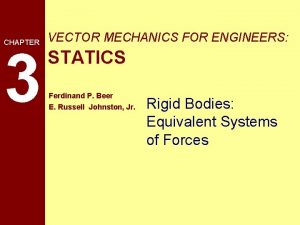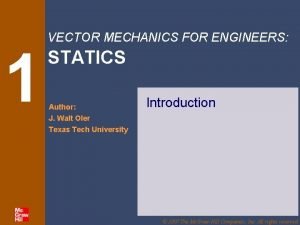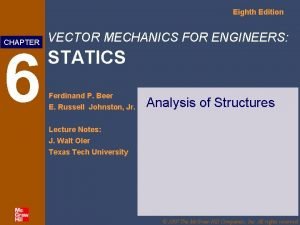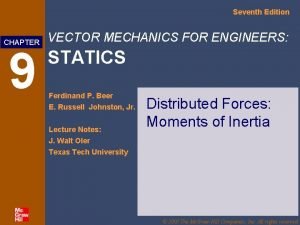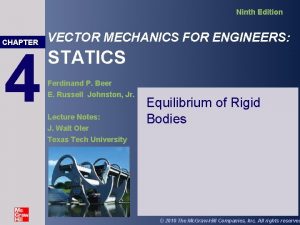Vector Mechanics For Engineers Statics Twelfth Edition Chapter




































- Slides: 36

Vector Mechanics For Engineers: Statics Twelfth Edition Chapter 5 Distributed Forces: Centroids and Centers of Gravity ©Akira Kaede/Getty Images RF © 2019 Mc. Graw-Hill Education. All rights reserved. Authorized only for instructor use in the classroom. No reproduction or further distribution permitted without the prior written consent of Mc. Graw-Hill Education.

Contents Introduction Theorems of Pappus-Guldinus Center of Gravity of a 2 D Body Sample Problem 5. 7 Centroids and First Moments of Areas and Lines Distributed Loads on Beams Sample Problem 5. 4 Centroids of Common Shapes of Areas Three-Dimensional Centers of Gravity and Centroids of Common Shapes of Lines Centroids of Common 3 D Shapes Composite Plates and Areas Composite Bodies Sample Problem 5. 12 Determination of Centroids by Integration © 2019 Mc. Graw-Hill Education. Sample Problem 5. 9

Application There are many examples in engineering analysis of distributed loads. It is convenient in some cases to represent such loads as a concentrated force located at the centroid of the distributed load. © 2019 Mc. Graw-Hill Education. © maurice joseph/Alamy

Introduction • The earth exerts a gravitational force on each of the particles forming a body – consider how your weight is distributed throughout your body. These forces can be replaced by a single equivalent force equal to the weight of the body and applied at the center of gravity for the body. • The centroid of an area is analogous to the center of gravity of a body; it is the “center of area. ” The concept of the first moment of an area is used to locate the centroid. • By knowing the centroid of a line or area, the determination of the area of a surface of revolution and the volume of a body of revolution can be accomplished through the Theorems of Pappus-Guldinus. © 2019 Mc. Graw-Hill Education.

Center of Gravity of a 2 D Body • Center of gravity of a plate • Center of gravity of a wire Access the text alternative for these images. © 2019 Mc. Graw-Hill Education.

Centroids and First Moments of Areas and Lines • Centroid of an area • Centroid of a line Access the text alternative for these images. © 2019 Mc. Graw-Hill Education.

Determination of Centroids by Integration 1 • Double integration to find the first moment may be avoided by defining d. A as a thin rectangle or strip. Access the text alternative for these images. © 2019 Mc. Graw-Hill Education.

Sample Problem 5. 4 1 Strategy: • Determine the constant k. • Evaluate the total area. • Using either vertical or horizontal strips, perform a single integration to find the first moments. • Evaluate the centroid coordinates. Determine by direct integration the location of the centroid of a parabolic spandrel. First, estimate the location of the centroid by inspection. Discuss with a neighbor where it is located, roughly, and justify your answer. © 2019 Mc. Graw-Hill Education.

Sample Problem 5. 4 2 Modeling: • Determine the constant k. Analysis: Evaluate the total area. © 2019 Mc. Graw-Hill Education.

Sample Problem 5. 4 3 • Using vertical strips, perform a single integration to find the first moments. © 2019 Mc. Graw-Hill Education.

Sample Problem 5. 4 4 • Or, using horizontal strips, perform a single integration to find the first moments. Try calculating Qy or Qx by this method, and confirm that you get the same value as before. © 2019 Mc. Graw-Hill Education.

Sample Problem 5. 4 5 • Evaluate the centroid coordinates. Is this “center of area” close to where you estimated it would be? Reflect and Think: You obtain the same results whether you choose a vertical or a horizontal element of area, as you should. In general, both methods can be used as a check against making a mistake in your calculations. © 2019 Mc. Graw-Hill Education.

Determination of Centroids by Integration 2 Often, the choice between using a vertical or horizontal strip is equally good, but in some cases, one choice is much better than the other. For example, for the area shown below, is a vertical or horizontal strip a better choice, and why? Think about this and discuss your choice with a neighbor. © 2019 Mc. Graw-Hill Education.

First Moments of Areas and Lines • An area is symmetric with respect to an axis if for every point P there exists a point is perpendicular to and is divided into two equal parts by • The first moment of an area with respect to a line of symmetry is zero. • If an area possesses a line of symmetry, its centroid lies on that axis. • If an area possesses two lines of symmetry, its centroid lies at their intersection. • An area is symmetric with respect to a center O if for every element d. A at (x, y) of equal area at there exists an area (−x, −y). The centroid of such an area coincides with the center of symmetry O. © 2019 Mc. Graw-Hill Education.

Centroids of Common Shapes of Areas Access the text alternative for these images. © 2019 Mc. Graw-Hill Education.

Centroids of Common Shapes of Lines Access the text alternative for these images. © 2019 Mc. Graw-Hill Education.

Composite Plates and Areas • Composite plates • Composite area © 2019 Mc. Graw-Hill Education.

Sample Problem 5. 1 1 Strategy: • Divide the area into a triangle, rectangle, and semicircle with a circular cutout. • Determine the centroid of each smaller area with respect to the axes. • Find the total area and first moments of the triangle, rectangle, and semicircle. Subtract the area and first moment of the circular cutout. For the plane area shown, determine the first moments with respect to the x and y axes and the location of the centroid. © 2019 Mc. Graw-Hill Education. • Compute the coordinates of the area centroid by dividing the first moments by the total area.

Sample Problem 5. 1 Modeling: • Find the total area and first moments of the triangle, rectangle, and semicircle. Subtract the area and first moment of the circular cutout. Access the text alternative for these images. © 2019 Mc. Graw-Hill Education. 2

Sample Problem 5. 1 3 Analysis: Compute the coordinates of the area’s centroid by dividing the first moments by the total area. Reflect and Think: Given that the lower portion of the shape has more area to the left and that the upper portion has a hole, the location of the centroid seems reasonable upon visual inspection. © 2019 Mc. Graw-Hill Education.

Theorems of Pappus-Guldinus 1 • Surface of revolution is generated by rotating a plane curve about a fixed axis. • Area of a surface of revolution is equal to the length of the generating curve times the distance traveled by the centroid through the rotation. © 2019 Mc. Graw-Hill Education.

Theorems of Pappus-Guldinus 2 • Body of revolution is generated by rotating a plane area about a fixed axis. • Volume of a body of revolution is equal to the generating area times the distance traveled by the centroid through the rotation. © 2019 Mc. Graw-Hill Education.

Sample Problem 5. 7 1 Strategy: • Apply theorem of Pappus. Guldinus to evaluate the volume of revolution of the pulley, which we will form as a large rectangle with an inner rectangular cutout. The outside diameter of a pulley is 0. 8 m, and the cross section of its rim is as shown. Knowing that the pulley is made of steel and that the density of steel is • Multiply the volume by density and acceleration due to gravity to obtain the mass and weight. determine the mass and weight of the rim. Access the text alternative for this image. © 2019 Mc. Graw-Hill Education.

Sample Problem 5. 7 2 Modeling: • Apply theorem of Pappus-Guldinus to evaluate the volumes of revolution for the larger rectangular section and the inner cutout section. • Multiply by density and acceleration due to gravity to get the mass and weight. Analysis: m = 60. 0 kg W = 589 N © 2019 Mc. Graw-Hill Education.

Distributed Loads on Beams • A distributed load is represented by plotting the load per unit length, w (N/m). The total load is equal to the area under the load curve. • A distributed load can be replaced with a concentrated load of magnitude equal to the area under the load curve and a line of action passing through the centroid of the load area. © 2019 Mc. Graw-Hill Education.

Sample Problem 5. 9 1 Strategy: • The magnitude of the concentrated load is equal to the total load or the area under the load curve. • The line of action of the concentrated load passes through the centroid of the area under the load curve. A beam supports a distributed load as shown. Determine the equivalent concentrated load and the reactions at the supports. © 2019 Mc. Graw-Hill Education. • Determine the support reactions by (a) drawing the free body diagram for the beam and (b) applying the conditions of equilibrium.

Sample Problem 5. 9 2 Modeling and Analysis: • The magnitude of the concentrated load is equal to the total load or the area under the load curve. F = 18. 0 k. N • The line of action of the concentrated load passes through the centroid of the area under the curve. Access the text alternative for these images. © 2019 Mc. Graw-Hill Education.

Sample Problem 5. 9 3 • Determine the support reactions by applying the equilibrium conditions. For example, successively sum the moments about the two supports: By = 10. 5 k. N Ay = 7. 5 k. N • And by summing forces in the x direction: Bx = 0 © 2019 Mc. Graw-Hill Education.

Three-Dimensional Centers of Gravity and Centroids • Center of gravity G • Results are independent of body orientation, • For homogeneous bodies, © 2019 Mc. Graw-Hill Education.

Centroids and Volumes of Common 3 D Shapes Access the text alternative for these images. © 2019 Mc. Graw-Hill Education.

Composite Bodies • Moment of the total weight concentrated at the center of gravity G is equal to the sum of the moments of the weights of the component parts. • For homogeneous bodies, © 2019 Mc. Graw-Hill Education.

Sample Problem 5. 12 1 Strategy: • Form the machine element from a rectangular parallelepiped and a quarter cylinder and then subtracting two 1 -in. diameter cylinders. Locate the center of gravity of the steel machine element. The diameter of each hole is 1 in. © 2019 Mc. Graw-Hill Education.

Sample Problem 5. 12 Modeling: © 2019 Mc. Graw-Hill Education. 2

Sample Problem 5. 12 Analysis: © 2019 Mc. Graw-Hill Education. 3

Sample Problem 5. 12 Reflect and Think: By inspection, you should expect 4 to be considerably less than (1/2)(2. 5 in. ) and (1/2)(4. 5 in. ), respectively, and to be slightly less in magnitude than (1/2)(2 in. ). Thus, as a rough visual check, the results obtained are as expected. © 2019 Mc. Graw-Hill Education.

End of Chapter 5 © 2019 Mc. Graw-Hill Education.
 Vector mechanics for engineers: statics 10th edition
Vector mechanics for engineers: statics 10th edition Mechanics
Mechanics Vector mechanics for engineers statics 10th edition
Vector mechanics for engineers statics 10th edition Vector mechanics for engineers 10th edition
Vector mechanics for engineers 10th edition Vector mechanics for engineers statics 12th
Vector mechanics for engineers statics 12th Line of action of force
Line of action of force Vector mechanics for engineers
Vector mechanics for engineers Vector mechanics for engineers
Vector mechanics for engineers Vector mechanics for engineers
Vector mechanics for engineers Vector mechanics for engineers: dynamics
Vector mechanics for engineers: dynamics Vector mechanics for engineers: dynamics
Vector mechanics for engineers: dynamics Vector mechanics for engineers: dynamics
Vector mechanics for engineers: dynamics Vector mechanics for engineers: dynamics
Vector mechanics for engineers: dynamics Vector mechanics for engineers: dynamics
Vector mechanics for engineers: dynamics Vector mechanics for engineers: dynamics
Vector mechanics for engineers: dynamics Overall expression
Overall expression Vector mechanics for engineers dynamics 12th
Vector mechanics for engineers dynamics 12th Vector mechanics for engineers dynamics 12th
Vector mechanics for engineers dynamics 12th Vector mechanics for engineers dynamics 12th
Vector mechanics for engineers dynamics 12th Management ricky griffin 12th edition pdf download
Management ricky griffin 12th edition pdf download Engineering mechanics moment of force problems
Engineering mechanics moment of force problems Rocker statics
Rocker statics Engineering mechanics: statics in si units
Engineering mechanics: statics in si units Mechanics of materials 7th edition solutions chapter 10
Mechanics of materials 7th edition solutions chapter 10 Mechanics of materials 9th edition solution chapter 7
Mechanics of materials 9th edition solution chapter 7 Mechanics of materials 7th edition solutions chapter 6
Mechanics of materials 7th edition solutions chapter 6 Mechanics of materials 6th edition solutions chapter 5
Mechanics of materials 6th edition solutions chapter 5 Mechanic of materials
Mechanic of materials Mechanics of materials chapter 4
Mechanics of materials chapter 4 Beer johnston
Beer johnston Beer johnston
Beer johnston Friction chapter in engineering mechanics
Friction chapter in engineering mechanics Fluid mechanics fundamentals and applications
Fluid mechanics fundamentals and applications Force vectors statics
Force vectors statics Statics
Statics Mis chapter 6
Mis chapter 6 Using mis (10th edition) 10th edition
Using mis (10th edition) 10th edition
